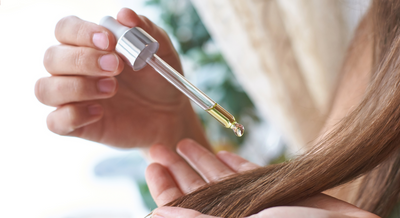It can be a tricky act of trying to keep your hair well-maintained and properly moisturized for proper hair health. And while much of this focus is placed on big things like hair styling tools and haircuts, sometimes it’s the little things we do to our hair that adds up to our long-term hair health. Read below for seven of our most important tips for small changes to your hair care routine that can lead to big results!
Change #1: Washing with Cooler Water
Few things are more relaxing and satisfying than a long, hot shower at the end of a tough day. However, all that hot water can be quite detrimental to the long-term health of your hair. Hot water can weaken the overall structure of the hair and wear down the outer cuticle layer, causing the hair strand to leech out moisture and become dry and dehydrated. Too much hot water can lead to your hair becoming weak and fragile, with additional detrimental effects occurring at the hair follicle, with the pores of the scalp widening and contributing to weakened hair growth. To avoid all this, try to make it a regular practice to wash your hair with cooler water. You don’t need to shower in freezing cold water, but just make sure to use less burning hot and more lukewarm water temperate.
Change #2: Using a Heat Protectant Before Styling
While there’s no shortage of heat styling tools on the market that utilize advanced technology to minimize breakage and heat damage, one can never completely minimize the risk that heat styling poses to the health of one’s hair. Although it may seem a bit annoying to add an extra step to your hair styling routine, there are numerous heat protectant products that come in an easy to use, spray form that coats the hair in a lightweight shield that helps to buffer the hair strand from direct heat application. Over time, this use of a heat protectant can keep your outer cuticle layer enact, leaving your hair feeling smooth, looking lustrous and shiny, and feeling healthy and hydrated. Some of the best heat protectant sprays even double as a pre-styler, making this a perfect way to boost your styling volume!
Change #3: Sleeping on a Silk Pillowcase
It may seem a bit odd, but did you know that when it comes to preventing breakage and hair loss, your best solution might come in your sleep environment? When you sleep, your hair rests directly against your pillow, and the constant tossing and turning at night creates friction, and it is this friction that can weaken the hair strand and lead to breakage over time. Thankfully, a pillowcase constructed with silk can help to mitigate this damage and create a soft surface that minimizes friction while you sleep. Silk is a smooth material that minimizes the friction of your hair rubbing against your pillow at night, helping to prevent breakage and leading to stronger, healthier hair.
Change #4: Applying SPF Protection to Your Hair
It’s common knowledge that we should all be applying some sort of SPF or sunscreen product on our skin to prevent the early signs of aging and sun damage. The sun emits harmful, drying waves of UV radiation that slowly break down the skin and lead to a loss of collagen and a degradation of skin health. Likewise, the sun can have a similarly harmful effect on your hair, causing it to break down the outer cuticle layer and lead to the hair’s early loss of pigment and follicle strength. Thankfully, numerous hair products contain some form of an SPF to keep the hair protected against the UV waves of the sun, allowing for healthier, stronger hair. Additionally, even natural hair oils like coconut oil contain a form of natural SPF, providing a form of protection that also gives the hair a massive boost of moisturization.
Change #5: Using the Correct Brush for Your Hair Type
Brushing can be a relaxing, therapeutic exercise that can help to straighten out the hair and undo any tangles or knots in the hair. For curly or highly textured hair, frequent brushing is a near necessity, being required to keep the hair in an organized condition. However, like many things in hair care, brushing one’s hair is a fine balancing act between self-care and damage, as improper brushing can cause snagging and even lead to breakage. To avoid any brushing issues, one needs to utilize a brush that has bristles compatible with his or her specific hair type. For straight hair, one should use a wide-tooth comb or brush with thick, rigid bristles, while those with textured, thick hair should use a brush with more thin, flexible bristles to avoid snagging.
Change #6: Applying a Hair Oil as Needed
When it comes to keeping your hair hydrated and healthy, much of the focus is placed on things like conditioning and hair masking. And while those things play a huge part in keeping your hair moisturized, even the best hair care plan can come up short when hair begins to feel dry and brittle throughout the day. For these cases, good hair oil is a lifesaver. When utilized on an as-needed basis throughout the day, hair oil can help to keep the hair hydrated and coat the cuticle layer with a rich layer of moisture to avoid any dryness or dehydration.
Change #7: Using a Weekly Deep Conditioner
A conditioner is a must whenever one uses a shampoo, as even the most greasy, oily hair needs to replenish the moisture lost during the process of hair washing. But for many hair types, this need to condition needs to be taken a step further. Enter the deep conditioner, which can be left in the hair after showering to provide the hair with a form of long-lasting conditioning to provide a more penetrative form of moisture that goes deep within the hair strand. With just one application a week, the use of a deep conditioner can keep the hair healthy and moisturized on a long-term basis.











